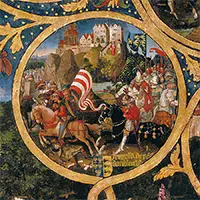Privilegium Minus: Austrian Method of Creation, Succession
The Privilegium Minus was an imperial declaration that gave rise to the Duchy of Austria. Holy Roman Emperor Frederick Barbarossa issued the declaration in 1156. 
Before that, Austria was a margraviate, ruled by a margrave, and had been since the granting of that status in the late 10th Century. The first Margrave of Austria was Leopold I (right), who founded the House of Babenberg in 976. A series of his successors followed him as ruler of Austria. In 1139, the German king Conrad III had given Margrave Leopold IV of Austria control of the Duchy of Bavaria. Two years later, Leopold died and his brother Henry took over, making his residence in Regensburg, capital of Bavaria. 
Henry II fought in the Second Crusade and barely survived defeat at the hands of the Seljuk Turks at the Battle of Dorylaeum, in 1147, and then was part of the unsuccessful Siege of Damascus, in 1148. One of the few who also survived the defeat at Dorylaeum was Frederick Barbarossa, who was elected King of the Romans in 1152 and then crowned Holy Roman Emperor in 1155. As a measure designed to settle the ongoing feud between the German Welf and Hofenstaufens, Barbarossa, in 1156, gave the Duchy of Bavaria to the Saxon prince known as Henry the Lion. Barbarossa then elevated the margraviate to duchy status and gave it complete independence from Bavaria, by issuing the Privilegium Minus. By the terms of this declaration, Henry II became the first Duke of Austria. The imperial declaration had other benefits for Henry. He and his second wife, Theodora Komnene, had three children: Agnes, Leopold, and Henry. All were still alive when the emperor issued the Privilegium Minus. But many a monarch had died without a son to succeed him and so, in order to forestall such an event, Barbarossa included in the declaration a provision that Henry could be succeeded by his daughter because he could choose his own successor. 
This provision turned out to be unnecessary because Henry's oldest son, Leopold, was alive when Henry died, in 1177, and so succeeded him. The next few successions were orderly as well. However, when Duke Frederick II of Austria (right) died, in 1246, he left behind no children. Surviving in his family were both a sister, Margaret, and a niece, Gertrude, both of whom could rightly stake a claim to succession by the terms of the Privilegium Minus, if interpreted liberally. Disagreements over this and other issues led to a succession struggle. |
|
Social Studies for Kids
copyright 2002–2026
David White




